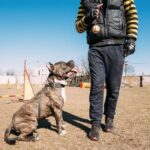Dog tracking is a fascinating skill that allows our furry friends to use their incredible sense of smell to follow specific scents and locate objects or individuals. Whether you want your dog to assist in search and rescue operations, find lost items, or simply engage in a fun and mentally stimulating activity, training them to track can be both rewarding and beneficial.
In this article, we will explore the world of dog tracking, its many benefits, and how it can strengthen the bond between you and your canine companion.
Dog tracking involves teaching a dog to follow the scent trail left by a person or object. This ability taps into their natural instinct as hunters and provides mental stimulation that keeps them physically active as well. Training your dog to track offers several advantages beyond just a fun activity.
It can aid in search and rescue efforts, helping locate missing persons or even saving lives in critical situations. Additionally, tracking allows dogs to engage their minds and expend energy while providing an outlet for natural instincts.
One of the most remarkable aspects of training your dog to track is the strengthening of the bond between you and your canine companion. Working together on tracking exercises requires trust, communication, and cooperation from both sides.
As you progress through various stages of training, you’ll create a stronger connection with your dog as they learn to rely on you for guidance and support. The shared experiences during tracking sessions also contribute to building mutual understanding and deepening the bond you have with your furry friend.
In this article, we will delve into the basics of dog tracking by exploring scent detection techniques and different types of dog tracking activities. We will also provide helpful guidance on choosing the right breed for tracking based on their innate abilities. Furthermore, we’ll discuss essential obedience commands necessary for establishing a strong foundation in tracking training. So let’s embark on this adventure together as we discover how to train our dogs to track.
Understanding the basics of dog tracking
Dog tracking is a fascinating activity that harnesses a dog’s natural sense of smell to follow scents and track objects or individuals. Scent tracking, also known as nose work, is an essential skill for many working dogs, such as search and rescue dogs and police K-9 units. Understanding the basics of dog tracking is crucial for anyone interested in training their dog in this rewarding activity.
Scent tracking involves teaching your dog to use their olfactory senses to follow and locate specific scents. Dogs have an extraordinary sense of smell compared to humans, with approximately 300 million olfactory receptors in their noses compared to our mere six million. This incredible sense of smell allows them to detect even the faintest traces of odors left behind by people, animals, or specific substances.
There are several different types of tracking activities that you can engage in with your dog. Trailing involves following a specific scent on the ground left by a person or animal, while air scenting focuses on detecting scents carried in the air. Urban tracking challenges dogs to navigate urban environments and distinguish between different scents amidst distractions.
To begin training your dog in the basics of tracking, it’s important to establish a strong foundation built on obedience commands, positive reinforcement, and focus development. Teaching essential obedience commands like sit, stay, and recall will provide you with greater control during tracking sessions.
A positive relationship based on reward-based training methods will motivate your dog to actively participate in tracking exercises. Additionally, working on enhancing your dog’s focus and attention will ensure they stay on task during tracking sessions.
By understanding the fundamentals of scent detection and recognizing how a dog’s sense of smell works, you can embark on an exciting journey of training your furry friend to become a skilled tracker. Once your dog has mastered the basics, you can progress to more challenging techniques and specialized training methods covered later in this guide.
Choosing the right breed for tracking
When it comes to training your dog to track, choosing the right breed is crucial. Not all dogs are well-suited for this type of work, as certain breeds have innate qualities that make them excel in tracking activities. Here are some factors to consider when selecting a breed for tracking:
Breeds that excel in tracking:
Certain breeds have a natural inclination and genetic predisposition for tracking. These include bloodhounds, German shepherds, Belgian Malinois, Labrador retrievers, and coonhounds. These breeds have been bred specifically for their exceptional scenting abilities and tracking instincts.
Characteristics to look for in a tracking dog:
Apart from the breed itself, there are certain characteristics that you should consider when choosing a dog for tracking. Look for dogs with a strong nose and keen sense of smell. They should show enthusiasm and focus when following scents or searching for objects. Dogs that exhibit high levels of energy, stamina, and drive tend to excel in tracking activities.
Considerations for selecting a breed based on your specific tracking needs:
Different types of tracking activities require different traits in dogs. For example, if you’re interested in wilderness search and rescue missions, breeds like bloodhounds or German shepherds would be suitable due to their ability to track scents over long distances and diverse terrains. On the other hand, if you’re interested in urban or air scent tracking, smaller breeds such as beagles or terriers may be more appropriate.
Remember that every individual dog is unique regardless of its breed characteristics. It’s important to assess each dog’s temperament, trainability, and personality to ensure compatibility with your training goals and lifestyle.
Things to Consider
- Physical attributes: Consider the size and physical capabilities of the breed you choose. Some breeds may not be suitable for certain terrain or weather conditions.
- Trainability: Look for breeds that are known for their intelligence, eagerness to please, and ability to learn quickly. This will make your tracking training sessions more effective and enjoyable.
- Compatibility with your lifestyle: Make sure the breed you choose fits well with your activity level and living situation. Some breeds require a lot of exercise, while others may be more low-energy.
By carefully considering these factors and understanding the specific needs of each breed, you can choose a dog that is best suited for tracking activities. Remember, the right breed will not only enhance your chances of successful tracking but also contribute to a more fulfilling and gratifying experience for both you and your four-legged companion.
Establishing a strong foundation for tracking
In order to train your dog to track, it is essential to establish a strong foundation of basic obedience and a positive relationship with your furry companion. This section will provide guidance on the necessary steps for creating this foundation, including teaching essential commands, emphasizing reward-based training, and fostering focus and attention in your dog.
One of the first steps in establishing a strong foundation for tracking is teaching your dog essential obedience commands. These commands, such as sit, stay, and recall, are crucial for maintaining control and ensuring safety during tracking exercises. By teaching these commands early on and reinforcing them consistently, you can create a solid groundwork for successful tracking sessions.
Reward-based training is another key aspect of building a strong foundation. Dogs are motivated by rewards such as treats, praise, or playtime, so incorporating positive reinforcement into your training sessions can help your dog associate tracking with positive experiences. When your dog successfully completes a tracking exercise or exhibits desired behavior during training, be sure to reward them promptly and enthusiastically.
Additionally, developing focus and attention in your dog is vital for effective tracking. Dogs naturally possess an acute sense of smell that they use during tracking activities but honing their ability to concentrate on the task at hand can enhance their tracking skills even further. You can encourage focus by gradually increasing the level of difficulty in exercises, introducing distractions gradually over time, and conducting regular mental stimulation activities outside of tracking sessions.
| Steps to Establishing a Strong Foundation for Tracking |
|---|
| Teach essential obedience commands (sit, stay, recall) |
| Emphasize reward-based training |
| Foster focus and attention through gradual challenges |
Introducing scent detection and tracking exercises
Step-by-step guide to introducing scent to your dog
In order for your dog to become proficient in tracking, they need to develop a strong understanding of scents and how to follow them. To introduce scent detection and tracking exercises, start by selecting a specific scent that you want your dog to track. This can be something natural like an essential oil or an artificial scent designed for training purposes.
- Begin by presenting the scent source to your dog so they can get familiar with it. Allow them to sniff the source and observe their reaction.
- Create positive associations with the scent by rewarding your dog with treats or praise whenever they show interest in the scent source.
- Gradually increase the difficulty level by hiding or placing the scent source in different locations for your dog to find.
- Encourage your dog’s natural curiosity and instinct by letting them search for the hidden scent source using their nose.
- Reward your dog every time they successfully locate the hidden scent and show indication such as barking, pawing, or sitting near it.
Teaching your dog to differentiate between scents
Once your dog has become familiar with tracking one specific scent, you can begin teaching them how to differentiate between scents. This skill is important as it allows them to focus on a particular target or individual during tracking sessions.
To teach this skill:
- Introduce multiple scents for your dog to sniff simultaneously.
- Reward them when they show interest only in the designated target scent that you want them to track.
- Gradually increase the number of scents presented and reinforce their ability to identify the correct scent by rewarding their accurate indication.
- Practice this exercise regularly to help your dog develop a strong ability to differentiate between different scents.
Basic tracking exercises to start with
Once your dog has successfully learned how to recognize and differentiate scents, you can start with basic tracking exercises. These exercises will strengthen their tracking skills and increase their confidence in following scents.
- Choose a familiar outdoor area with minimal distractions for the initial tracking exercises.
- Begin by creating short tracks using the designated scent source, laying a small scent trail that your dog can follow.
- Walk a straight line, making sure to contaminate the track with your footsteps to simulate real-life scenarios where multiple scents may be present.
- Encourage your dog to track by using verbal cues or hand signals, and provide rewards along the way when they display indication of locating the target scent.
- Gradually increase the difficulty by adding turns, obstacles, or varying terrain as your dog becomes more proficient in tracking.
By carefully following these steps and gradually increasing the difficulty level, you can effectively introduce scent detection and tracking exercises to train your dog in this valuable skill. Remember to be patient, consistent, and reinforce positive behaviors throughout the training process.
Progressive training techniques for dog tracking
Once your dog has developed a solid foundation in tracking, it’s time to progress to more advanced techniques that will further enhance their skills. Progressive training techniques are designed to challenge your dog’s abilities and push them to reach new levels of tracking proficiency. Here are some strategies to consider when incorporating progressive training techniques into your dog’s tracking routine:
- Advancing the difficulty level of tracking exercises: As your dog becomes more confident in their tracking abilities, gradually increase the difficulty of the tracks you lay out for them. This can include making the scent trail longer, adding turns and corners, or introducing different surfaces and terrains for them to navigate. By continuously challenging your dog, they will develop better problem-solving skills and become more adept at following complex scent trails.
- Gradually increasing the duration and distance of tracks: Start by setting shorter tracks for your dog, allowing them to successfully locate the target scent. As they become more proficient, gradually extend the distance and duration of the tracks. This will not only improve their stamina but also teach them to maintain focus and concentration over longer periods of time.
- Incorporating distractions and challenges: Introducing distractions during tracking exercises is an excellent way to prepare your dog for real-life scenarios where distractions are likely to be present. You can use toys, food rewards, or even other people or animals as distractions along the track. Teaching your dog to remain focused on the target scent despite these distractions will significantly enhance their tracking abilities.
Remember that progressive training should always be done at a pace that is appropriate for your individual dog’s abilities and comfort level. Pushing them too quickly can lead to frustration or confusion, while progressing too slowly may hinder their development. Observe your dog’s behavior closely during training sessions and adjust accordingly to ensure their success.
Incorporating progressive training techniques into your dog’s tracking routine will help them build on their existing skills and continue to grow as a tracking dog. By challenging them and gradually increasing the difficulty of their training, you will be amazed at the level of precision and focus they can achieve. Stay patient, consistent, and always provide positive reinforcement to keep your dog motivated and engaged in their tracking journey.
Advanced tracking techniques and specialized training
Once your dog has mastered the basics of tracking, you can start implementing advanced techniques and specialized training to further enhance their tracking skills. This section will explore different ways to train your dog to track specific scents, navigate different environments and terrains, as well as opportunities for advanced tracking certifications and competitions.
One important aspect of advanced tracking is teaching your dog to track specific scents. This can include human scent or animal scent, depending on the purpose of your tracking activities. To introduce your dog to a specific scent, you can use scent articles or target objects that are associated with the desired scent. Through repetition and positive reinforcement, your dog will learn to identify and differentiate between different scents.
Training for different environments and terrains is also crucial for advanced tracking. Dogs need exposure to diverse settings such as rocky terrain, marshy areas, or urban environments in order to be versatile trackers. Gradually introducing your dog to these various environments will help them adapt and apply their tracking skills effectively regardless of the surroundings.
For those interested in taking their dog’s tracking abilities to a competitive level, there are specialized certifications and competitions available. These events assess a dog’s proficiency in areas such as obedience during tracking, following complex tracks with multiple turns or cross-tracks, and working in challenging scenarios like urban search operations. Participating in these competitions not only provides an opportunity for growth but also allows you to connect with other passionate trainers and enthusiasts.
Overall, advanced tracking techniques and specialized training offer exciting possibilities for both you and your four-legged companion. By continuously challenging your dog’s skills and expanding their knowledge in various aspects of tracking, you can build a strong bond with them while enjoying an enriching activity together.
| Technique/Training | Description |
|---|---|
| Scent Differentiation | Teaching your dog to differentiate between different scents, such as human scent or animal scent, by using scent articles or target objects. |
| Training in Different Environments and Terrains | Gradually exposing your dog to various environments and terrains (e.g., rocky terrain, urban settings) to make them adaptable and versatile trackers. |
| Specialized Tracking Certifications and Competitions | Participating in certifications and competitions that assess advanced tracking skills, obedience, and performance in challenging scenarios. |
Troubleshooting common challenges in dog tracking
In the process of training your dog to track, you may encounter some common challenges. It’s important to address these challenges effectively so that you can maintain progress and ensure a positive training experience for both you and your dog. Here are some troubleshooting tips for common challenges in dog tracking:
- Dealing with distractions and obstacles during tracking: Dogs can easily get distracted by various scents, noises, or other events happening around them while tracking. To help your dog stay focused on the track, gradually expose them to distractions during training sessions. Start with minimal distractions and gradually increase their intensity as your dog becomes more proficient in tracking. Use positive reinforcement techniques to encourage your dog to stay focused on the track despite distractions.
- Addressing issues like loss of interest or motivation: If your dog shows signs of losing interest or motivation during tracking, it could be due to various reasons such as fatigue, boredom, or lack of challenge. Keep the training sessions short and engaging to prevent boredom. Introduce new challenges gradually to keep your dog mentally stimulated and motivated. Incorporate rewards and praise whenever your dog successfully completes a tracking task to reinforce their enjoyment and motivation.
- Overcoming setbacks and maintaining progress in tracking training: Tracking can have its ups and downs, so it’s important not to get discouraged by setbacks along the way. If your dog struggles with a particular aspect of tracking, go back a few steps in the training process and reinforce those skills before moving forward again.
Break down difficult tasks into smaller components that your dog can easily grasp, rewarding each small achievement along the way. Be patient with your dog as they learn and remember that consistency is key for successful training.
By addressing these common challenges effectively, you can overcome obstacles in the tracking journey with your dog and continue progressing towards becoming a confident tracking team. Remember that every dog is unique, so don’t shy away from seeking professional assistance if needed for specialized guidance tailored to your dog’s specific challenges. With consistency, patience, and dedication, you and your dog can develop strong tracking skills and enjoy the many benefits that come with it.
Safety precautions and considerations during tracking sessions
When training your dog to track, it is crucial to prioritize their safety and well-being during tracking sessions. By taking certain precautions and considering various factors, you can create a safe and enjoyable environment for both you and your furry companion. Here are some essential safety precautions and considerations to keep in mind during tracking sessions:
- Ensuring your dog’s physical and mental well-being: Before embarking on a tracking session, assess your dog’s overall health condition. Ensure they are up-to-date on vaccinations and free from any injuries or illnesses that could be exacerbated during the activity. Additionally, consider your dog’s age, energy level, and fitness level when planning the duration and intensity of the tracking session.
- Preparing for outdoor tracking sessions: When conducting tracking exercises outdoors, it is essential to take necessary precautions. Dress appropriately for the weather conditions to ensure both your comfort and safety. Also, make sure to bring along any necessary gear such as proper footwear, insect repellent, sunscreen, water bottles for hydration (both for you and your dog), a first aid kit, extra leashes or longlines, treats or rewards for training purposes.
- Understanding the limits and limitations of tracking activities: Recognize that every dog has its strengths and limitations when it comes to tracking. Be mindful of your dog’s breed characteristics and individual abilities when setting training goals or pushing them outside of their comfort zones. It is important not to push your dog beyond their physical or mental capabilities as this could lead to stress or injury.
By following these safety precautions and considerations during tracking sessions, you can help ensure a positive experience for yourself and your dog. Remember that safety should always be a top priority when engaging in any form of training activity with your canine companion.
Conclusion and final tips for successful dog tracking
In conclusion, training your dog to track can provide numerous benefits for both you and your furry companion. By understanding the basics of dog tracking and choosing the right breed, you can establish a strong foundation for tracking success. Introducing scent detection and tracking exercises, along with progressive training techniques, will help develop your dog’s skills in tracking. And finally, by troubleshooting common challenges and prioritizing safety during tracking sessions, you can ensure a successful and rewarding tracking experience.
Throughout this article, we have explored the world of dog tracking from its definition to its various types and benefits. We have also discussed how to choose the right breed for tracking based on their characteristics and your specific needs. By establishing a strong foundation through essential obedience commands and building a positive relationship through reward-based training, you set the stage for successful tracking training.
We have also delved into introducing scent detection exercises to educate our dogs on differentiating scents and progressing towards basic tracking exercises. Advancing the difficulty level gradually, incorporating distractions, and honing their skills in specialized environments contribute to enhancing their overall tracking abilities.
Moreover, we have considered common challenges such as distractions or loss of interest that may arise during training sessions. Understanding how to overcome setbacks is crucial for maintaining progress in your dog’s tracking journey.
Lastly, ensuring safety during training sessions is paramount. Taking precautions such as preparing outdoor gear and being mindful of weather conditions helps ensure your dog’s physical well-being. Additionally, knowing the limits and limitations of tracking activities safeguards both you and your canine partner.
Frequently Asked Questions
How do you train a dog to track?
Training a dog to track involves teaching them to follow scent trails and locate specific objects or individuals. The first step is usually introducing the concept of scent detection by using treats or toys with strong smells. As the dog becomes familiar with this exercise, you can gradually progress to more complex tracking tasks.
One common method is to lay a trail of scent for the dog to follow, gradually increasing the length and difficulty over time. Using positive reinforcement, such as praise and rewards, is crucial throughout the training process. It’s important to be patient and consistent while training a dog to track, as it can take time for them to fully grasp the concept and develop their tracking skills.
When should I start training my dog for tracking?
The ideal time to start training a dog for tracking depends on various factors, including their breed, age, and individual characteristics. Generally, it’s recommended to introduce basic scent games or activities when the dog is still a puppy. This can help them develop an understanding of using their nose and following scents at an early age.
However, formal tracking training is typically initiated when the dog is around 6-12 months old since their physical growth should be sufficient for more intense training sessions. Starting earlier allows for longer periods of learning and practice before they reach maturity. However, it’s worth mentioning that dogs of any age can be trained for tracking if they have the necessary physical capabilities and motivation.
Can any dog be a tracking dog?
While most dogs possess some level of olfactory abilities that enable them to track scents, not all dogs are suitable for professional or advanced tracking work. Breeds with primarily scent-oriented backgrounds like bloodhounds or German Shepherds are often chosen as excellent candidates due to their innate sniffing abilities and natural inclination towards tracking behavior. However, with appropriate training, many different breeds can become competent tracking dogs.
Size does not necessarily limit a dog’s potential in this field either; both large and small breeds have shown remarkable success in tracking activities. Ultimately, a dog’s success as a tracking dog depends on their individual drive, intelligence, and willingness to learn, rather than solely their breed or size.

Welcome to the blog! I am a professional dog trainer and have been working with dogs for many years. In this blog, I will be discussing various topics related to dog training, including tips, tricks, and advice. I hope you find this information helpful and informative. Thanks for reading!





